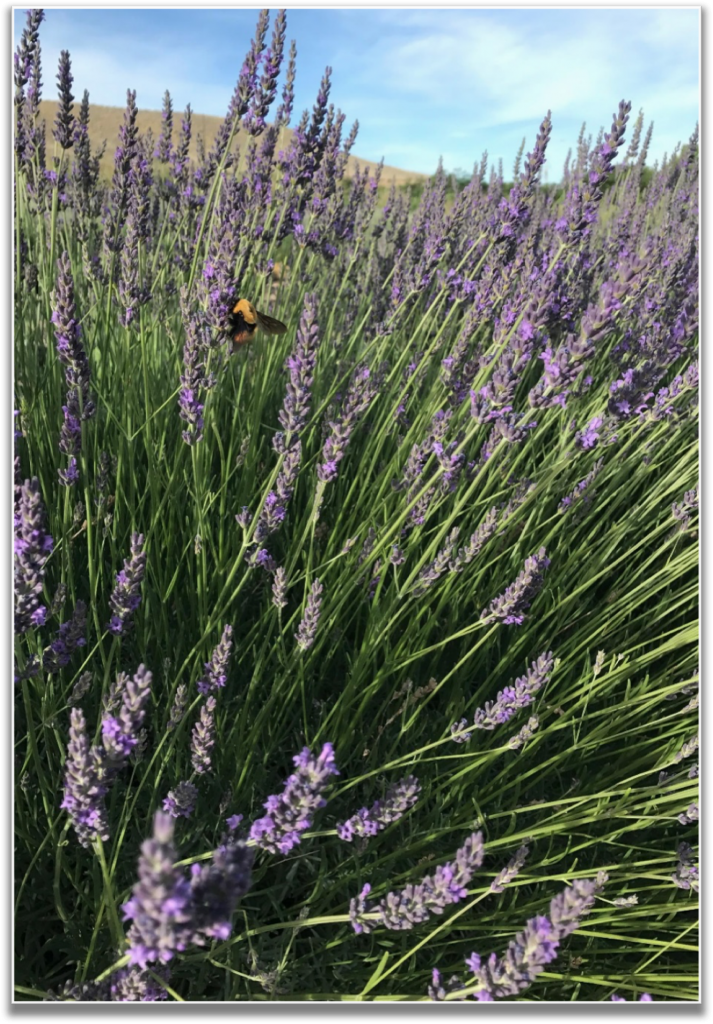Lavender blooms in every color except orange. It grows in the misty mountains of Hawaii, across the rolling hills of France, in the temperate landscape of California – and in the high desert and Rocky Mountains of Colorado.
This versatile plant can call so many places home. But not all lavender is alike. Choosing the right species of lavender for any given place is what allows us to enjoy this aromatic beauty around the world.
In Colorado’s high desert and Rocky Mountains, there are three lavender species we know will tolerate and even thrive in our extreme climate (Zone 4b and warmer).
But before we dive into species, we should first understand the botanical names of lavender.
Understanding botanical names
All lavenders come from the genus Lavandula. This genus will be listed first in a botanical name and capitalized or abbreviated by “L.“.
The species name, which always follows the genus, identifies a specific genus. The species remains lower case.
For example, the lavender known by the common name “True Lavender” is properly labeled Lavandula angustifolia. Lavandula is the genus; angustifolia is the species.
Typically, a plant’s botanical name includes a third identifier: the cultivar. A cultivar is selected from natural seedling mutations and cultivated by humans to create a distinct cultivated variety. Cultivars are always propagated from vegetative cuttings rather than from the seeds.
For example, ‘Royal Velvet’ is a cultivar. The botanical name would read as follows: Lavandula angustifolia ‘Royal Velvet’.
Side-note: cultivar vs. variety
Though some cultivars can occur in nature as plant mutations, most cultivars are developed by plant breeders and are called hybrids.
A cultivar comes from a plant mutation and does not produce true-to-seed (which is why cuttings are necessary). A variety is a group of plants within a species, has one or more distinguishing characteristics, and usually produces true-to-seed (i.e. a variety can reproduce itself from seed).
Nomenclature is important.
Is it English or is it French or is it Spanish? So confusing….
In the US, Lavandula stoechas refer to “Spanish” lavender; in the UK they are called “French”. In France, French lavender is L. dentata. In Australia L. stoechas is called Italian lavender.
This is the correct way if you are using the common language:
L.x. intermedias are called ‘lavandins’ (a cross between angustifolia & latifolia)
Lavandula angustifolia is referred to as ‘Common Lavender’ or ‘True Lavender’
L. stoechas is technically French lavender, as it came from the Southern Coast of France
Three perennial species that grow well in Colorado
Lavandula angustifolia

- Common name: True lavender
- Uses
- Primary source for essential oil used in perfume and aromatherapy
- Shorter stem makes for smaller bouquets
- Preferred culinary variety: Delicate flavor from blossoms makes delicious addition to both savory and sweet dishes
- The most cold-hardy species: -10°F to -25°F
- Will grow above 6,000 feet to 7,800 feet
- Multiple colors: dark purple, blue violets, lavender, pink, white
- Double bloomers
- Distillation
- Sweet to Minty Aroma
- Chemical dominance: Esters and alcohols
Lavandula x. intermedia
Hybrid of L. angustifolia and L. latifolia (“Spike lavender”); also known as ‘Grosso’ or Lavandin

- Common name: Lavender ‘Grosso’ or ‘Fat Spike Grosso’
- Has a three-pronged stem
- Uses:
- Essential oil – Produce highest yields of flowers and highest concentrations of essential oil per acre
- Crafting
- Show stopper
- Long Stems & Spikes
- Foliage is good for grilling and red meats
- Distillation:
- Essential Oil
- Camphor smell/bitter taste
- Chemical Dominance: alcohols and esters
- Hardy to 0°F to -15°F depending on cultivar
- Not recommended to grow above 6,000-6,500 feet
- Plant spacing 3 to 4 foot spacing
Lavandula x. chaytorae
Hybrid of L. angustifolia (English lavender) and L. lanata (Wooly lavender)

- Common name: Wooly English cross.
- The cross did not occur in the wild as the natural distribution of the parents did not overlap. The cross was first made in a nursery in the UK in the 1980’s since then further crosses have been made and now there are quite a few cultivars available. ‘Silver Frost’, ‘King Richard’, ‘Ana Luisa’, ‘Lisa Marie’
- L. x. chaytorae makes an excellent and attractive ornamental for the garden, containers and hedging. It retains the hardiness of the L. angustifolia parent yet has the wonderful attractive richly silver grey leaves from the L. lanata parent.
- L. x. ‘Ana Luisa’ is one of the largest growers in this new species reaching a height of 36 to 42 inches. Originating in Oregon at the Van Hevelingen Herb Nursery in 1998.
- Hardy to 0°F to -10°F depending on cultivar
- Minimum Zone 4b and Zone 5 for 3 species mentioned
- REMEMBER! Irrigation details matter: Lavender is drought tolerant but not good with drought stress (long period of high heat can stress out the plant); Moreover lavender is susceptible to root rot so let soil dry out between watering.
Get a gift certificate to our plant nursery and plant lavender in your garden this year!
Order lavender plants for spring planting – Click here to view availability
Which lavender species sounds the most wonderful to you?
What’s something you learned from this post about lavender that you didn’t know before?
Tell us in the comments below!


Cathy Ramsey
This was very helpful. I did not know about the chaytorae. Thanks so much! I love all your blogs; they are so interesting.
Kelly Cox
Paola, thank you for the refresher on Genus / Species naming! Lovely lavender. We are so gifted to be able to grow three species here in our high desert home. Thank you for all the passion and talent you share at Sage Creations! KC
Nina Howard
Hi, we are at 8500 feet of elevation in the Colorado high country plains. We had lowest temperatures to -12-15 this winter only for a few days we want to grow lavender on about an acre. What should we start with? Thank you for your response. Nina